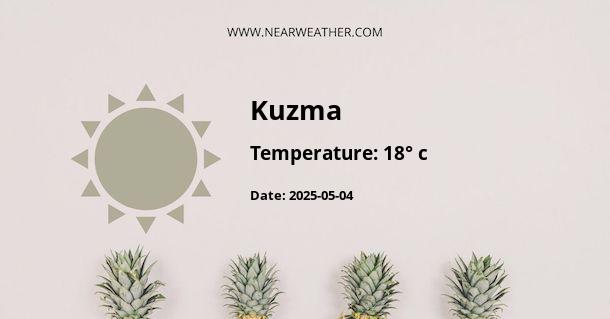The Climate and Weather of Kuzma, Siberia Throughout the Year
The Siberian town of Kuzma, situated in an expansive region characterized by its generally harsh climate, experiences significant seasonal variations. Understanding the climate patterns and weather conditions of Kuzma is essential both for residents and for visitors who may be traversing its vast, often unforgiving terrain.
Kuzma's Geographic and Climatic Context
Kuzma is located in Siberia, a vast region in Russia noted for its subarctic climate. This location is defined by long, extremely cold winters and short, mild summers. The Siberian High, a large mass of cold dry air that comes from the Arctic Ocean, largely influences the weather patterns in this region.
Temperature Overview
"Siberia's most defining climatic feature is undoubtedly its wide temperature amplitude, with Kuzma being no exception. Winter temperatures can plummet to below -40°C (-40°F), while summers can see mercury levels climbing to about 20°C (68°F)." – Siberian Climate Monitoring Agency
Winter in Kuzma
- Temperature: Average daily high temperatures in winter can range drastically but typically stay below freezing, often sitting between -20°C and -30°C. Nighttime lows can be even more severe.
- Snow and Ice: Snowfall is heavy and regular, with a consistent snowpack maintained throughout the season. Ice storms and blizzards can be common occurrences, creating transport and infrastructure challenges.
- Wind: The Siberian winds contribute significantly to the wind chill factor, making the effective temperatures feel even colder than what the thermometers indicate.
Spring in Kuzma
- Temperature: Spring brings about a gradual increase in temperatures, moving from the frigid extremes of winter to more bearable, yet still cold, conditions.
- Melting Snow and Ice: The transition from winter to spring often results in melting snow, leading to potential flooding issues as rivers swell with the meltwater.
- Daylight: The increase in daylight hours during spring contributes to the melting process and a slow return of foliage and wildlife activity.
Summer in Kuzma
- Temperature: Summer temps are generally mild with average highs around 20°C, although heatwaves can push temperatures higher on occasion.
- Precipitation: Summer is also the wettest season, with regular rainfall contributing to lush green landscapes and a surge in the region's biodiversity.
- Long Days: With its northern latitude, Kuzma experiences long days during the summer months, with near-constant daylight known as the "White Nights" around the summer solstice.
Autumn in Kuzma
- Temperature: Early autumn can still be mild, but temperatures quickly begin to drop as the season progresses, reaching the winter norms by late autumn.
- Fall foliage: Before the onset of the severe cold, Kuzma's surroundings are adorned with a brief but vibrant display of fall foliage.
- First Snow: The first snowfall can arrive as early as September, heralding the return of the long Siberian winter.
Annual Precipitation
Precipitation in Kuzma varies throughout the year, with an annual average that tends to be on the lower end due to the overall dry climate of Siberia. The majority of the area's precipitation falls as snow during the winter months, while summer sees most of the rainfall.
| Season | Average Precipitation |
|---|---|
| Winter | 20-30mm |
| Spring | 10-20mm |
| Summer | 40-70mm |
| Autumn | 20-40mm |
Extreme Weather Events and Climate Change
As is the case with much of the Arctic and subarctic regions, Kuzma is not immune to the effects of climate change. Increased global temperatures have led to noticeable changes, including:
- Thawing Permafrost: The thawing of historically frozen ground has begun to affect infrastructure and natural ecosystems.
- Increased Fire Risk: Drier conditions and warmer temperatures have elevated the risk of wildfires, even in these typically cold regions.
- Changing Fauna Patterns: The distribution and behavior of wildlife have been affected, with some species moving further north as temperatures warm.
Additionally, extreme weather events, such as unexpected warm spells in winter or sudden cold snaps in summer, have become more frequent, posing challenges for both the populace and local governance in terms of preparedness and response.
Travel and Lifestyle Considerations
For those planning to visit or live in Kuzma, it is crucial to be prepared for the severe weather conditions. Here are some recommendations:
- Invest in high-quality, insulated clothing for winter, especially if engaging in outdoor activities.
- Be aware of the daylight fluctuations throughout the year—understanding the patterns can help alleviate the psychological impacts of the long dark winters or continuous summer light.
- Stay informed on weather forecasts and advisories, particularly when traveling, as sudden weather changes can occur.
Concluding on Kuzma's Weather and Climate
The weather and climate of Kuzma, as with much of Siberia, demand respect and preparation. Understanding the region's unique climactic quirks and seasonal variations ensures better personal safety and enjoyment of the natural beauty that Kuzma offers. Whether braving the winter chill or basking in the brief but pleasant summer, knowledge of the local weather patterns is an indispensable tool for any visitor or resident.
This foresight, coupled with appropriate measures and an appreciation for the potential impacts of climate change, not only preserves personal well-being but also contributes to a sustainable coexistence with the often extreme yet majestic Siberian environment.
A - Kuzma's Latitude is 46.836941 & Longitude is 16.083330.
A - Weather in Kuzma is 12° today.
A - Climate Conditions in Kuzma shows overcast clouds today.
A - Humidity in Kuzma is 43% today.
A - Wind speed in Kuzma is 6.44 km/h, flowing at 163° wind direction. today.
